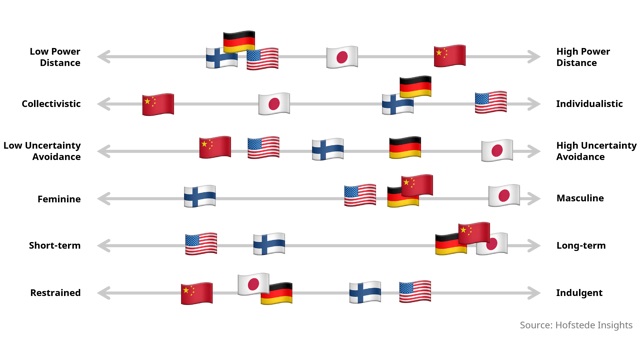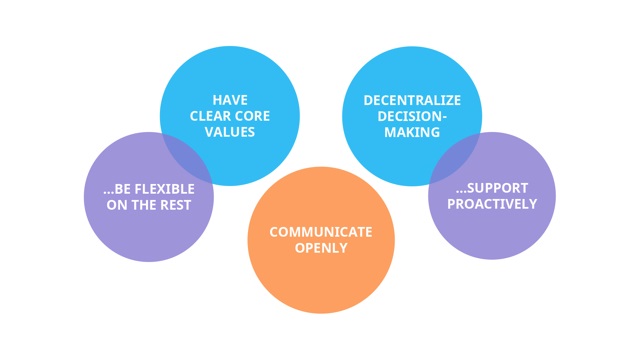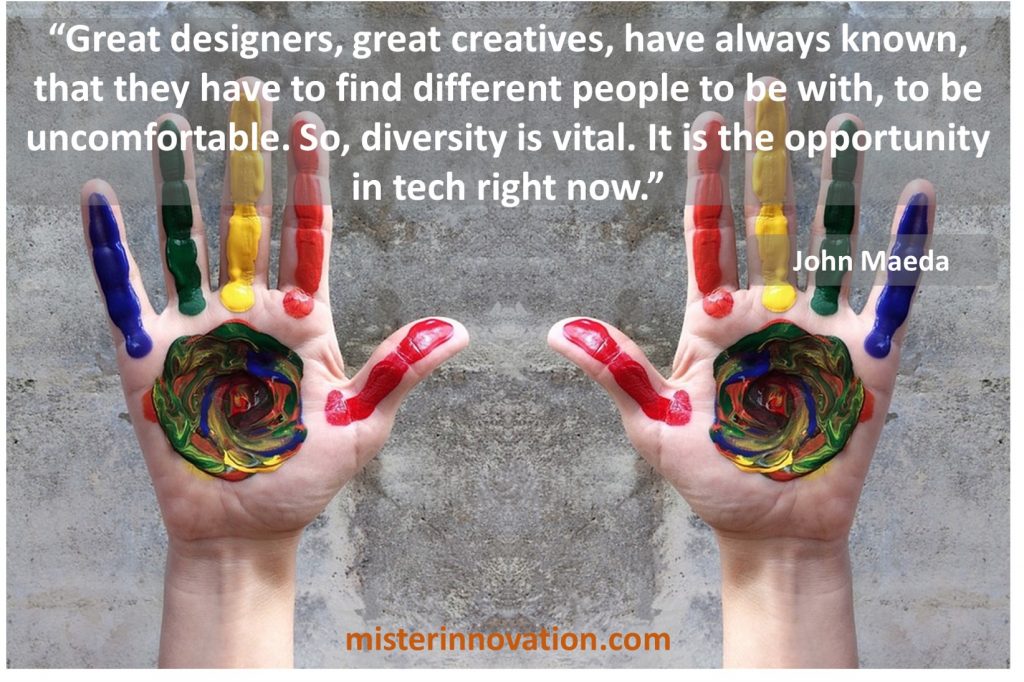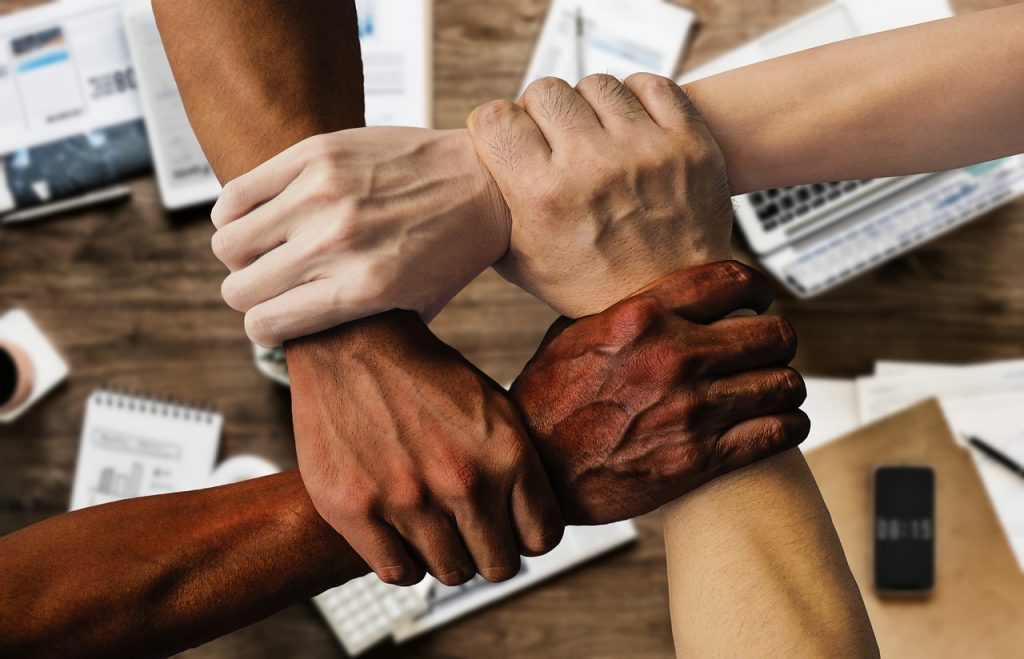
GUEST POST from Jesse Nieminen
The effects of cultural differences for innovation are an interesting and extremely multifaceted topic.
For most of us, it probably goes without saying that cross-cultural and multicultural capabilities are crucial in today’s globalized and hyperconnected world, and innovation is no exception. These capabilities are especially important if you’re working on it in a large international organization, as many of our customers are.
Such an organization must obviously think about how to adapt new innovative products and services to the cultures and unique characteristics of different markets and regions. But, in addition to that, they also need to manage the cultural differences within their organization while trying to innovate. Given that we have customers all over the world, it’s a theme we often get asked about.
And, of course, there’s also the age-old debate about the cultures of certain regions or countries being better suited to innovation to begin with.
So, in this today’s article, we’ll dive deeper on this nuanced topic and each of those three themes around cultural differences in innovation. We’ll also end by providing you with practical advice on how to look at and take these into account in your innovation work.
How can cultural differences be observed?
However, before we dive deeper, let’s first take a step back and consider the question of how to observe cultural differences in the first place.
I’m sure we all agree that there are significant cultural and behavioral differences between people coming from different backgrounds, be it based on geographical, ethnic, religious, or just the past corporate cultures people have been a part of.
As these differences are often hard to pin down, people usually have an innate urge to try to group people into specific buckets to make sense of those differences. There are significant challenges in doing that as it can lead to putting people into predefined boxes and reinforcing stereotypes, and then treating people based on those stereotypes instead of the individuals they really are. That is why these kinds of approaches shouldn’t be considered universal truths or used as recipes for making decisions even from a purely pragmatic point-of-view, let alone from an ethical one.
Still, with that major caveat, there are also benefits in using such frameworks since they can help us make sense of the world in a more structured way. They can help everyone get a better understanding of the big picture and can serve as a starting point for creating a shared understanding, as well as debating the practical implications of cultural differences.
There are many such methods available, but the general approach is always the same: to break a culture down into several behavioral and/or value-based dimensions ranging from one extreme to another, and then rating each culture on each of these dimensions to form an overview of their respective cultures.
The most popular and widely researched of these are probably the GLOBE project, and the Hofstede cultural dimensions model, but there are also other popular ones like the Culture Map. Each of these frameworks uses the above described approach, and most of the research on them is primarily focused on the differences between individual nations. Having said that, the same approaches have also been applied to other levels, such as gender, organizational, etc. often just with slightly different dimensions.
Next, we’ll briefly explain the Hofstede cultural dimensions model because it’s one of the earliest, and by far the most popular model in the field. If you’re already familiar with the model, you can skip the next paragraph and jump right into the takeaways.
Hofstede’s Cultural Dimensions
Geert Hofstede worked at IBM back in the 60’s when it was one of the first true global, multinational corporations. As part of his work on improving cross-cultural communication, he ran the same survey on values for more than 100,000 employees from different countries and analyzed the differences, which then led to the creation of his model some years later.
Initially the model consisted of four dimensions, but upon additional research, has since been expanded to six. I’ll briefly explain each of these next, and then share a few examples to illustrate how that works.
Power Distance Index (PDI) determines how equally power is distributed and how hierarchical a society is. High scores indicate a structured and hierarchical society, whereas low values indicate a more distributed power structure and willingness to question authority.
Individualism vs. Collectivism (IDV) looks at how heavily individuals are integrated into groups. This is mostly self-explanatory, but it’s worthy pointing out that collectivist cultures are highly loyal to the close-knit groups they belong to.
Uncertainty Avoidance (UAI) determines how much ambiguity and uncertainty a society is comfortable with. High scores indicate that a society values clear, often strict, rules and guidelines and believes in there being a “singular truth”. Low scores mean that a society is more willing to explore new ideas and divergent thoughts and is less structured overall.
Masculinity vs. Femininity (MAS) is of a dimension that’s subject to some controversy, but here refers to values associated with traditional gender roles. A masculine society values achievement, assertiveness, and material rewards for success, whereas a more feminine one values cooperation, modesty, care, and quality of life.
Long-term orientation vs. Short-term orientation (LTO) is pretty self-evident. Long-term oriented societies tend to think more about the future and view adaptation and pragmatic problem-solving as important, whereas more short-term oriented one tends to value traditions and the current state and be less willing to change.
Indulgence vs. Restraint (IND) in turn refers to how much a society indulges and encourages freedom for individuals to “just have fun and enjoy life”. More restrained societies tend to have stricter social norms regarding such behavior as they see these indulgences as counter-beneficial for bigger, longer-term ambitions.
There’s been some research on how these tendencies affect innovation, and as you can probably guess, some tend to be more favorable for high innovation performance than others. Which brings us to the big question: are some cultures intrinsically better at innovation than others?
Are some cultures better than others at innovation?
Well, in short, the answer is yes. At least to some extent. As mentioned, there’s research that shows a relatively strong correlation between certain cultural characteristics and innovation performance.
However, here it’s worth pointing out that almost all of the research done on the topic would seem to focus on country level data as that is widely and freely available thanks to studies like the Global Innovation Index (GII).
While certainly useful, we should take these findings with a grain of salt due to a number of factors, such as the studies again being high-level generalizations based on correlations, and the indices like GII being predominantly focused on inputs for innovation such as education and R&D spending. Even the output focused parts tend to be a bit biased towards activity metrics, such as number research papers and patents, instead of the real value and economic impact of innovation.
What’s more, I think it’s important to point out that most natural cultures evolve much slower than the GII rankings change, so it should be quite evident that there are also many other factors than culture that affect these scores.
But with that out of the way, let’s now look at the actual findings.
Characteristics of top innovation cultures
Based on the available studies, there would seem to be a pretty good consensus on the ideal innovation cultures having the following characteristics on the Hofstede model, in rough order of importance:
- Low power-distance
- High levels of long-term orientation and pragmatism
- High levels of individualism
- High levels of indulgence
- Low levels of uncertainty avoidance
- Lower levels of masculinity
These findings are obviously mostly in line with what most of us think of as a pro-innovation culture, so there aren’t really that many surprises here.
If people can question authority, are comfortable with ambiguous and uncertain environments, and can think about the long-term instead of just the next quarterly results, innovation is a lot more likely to happen.
While there’s more to innovation performance than culture, certain characteristics are likely to lead to a culture being better at innovation.
In most studies, the level of masculinity seemed to make the least amount of difference of any of the variables for innovation performance. Some studies found no correlation, but some did find a preference for a feminine, more collaborative culture instead of the more competitive and assertive, masculine one.
However, in my opinion, the most interesting findings are that high levels of individualism and indulgence are favorable for innovation, when intuitively we might think that a culture that is more collaborative and favors restraint and delayed gratification would be preferable.
This can be explained with the way that the Hofstede dimensions are constructed.
A more collaborative culture is one where certain in-groups, typically your own family, come first, and where loyalty and obedience are absolute values. So, collaboration according to the Hofstede model isn’t so much for the “greater good”, but more about the benefit of that specific “inner circle” ahead of your own interests. More individualist societies, on the other hand, tend to be more comfortable disagreeing, exploring, and “letting the best ideas win”, which is what likely led to these cultures over-performing.
A similar explanation also applies for the preference for indulgence. According to the authors of the study linked above, people in indulgent cultures have a greater drive for improving things and making life more enjoyable, and are generally more optimistic, which they viewed as the primary factors driving innovation here, perhaps alongside a general willingness to just try new things.
So, in that context, I do think the findings make sense, but I think it’s also a good example of some of the challenges associated with more nuanced sides of these cultural frameworks.
Takeaways from country level innovation performance
Looking at the GII study, and the mapping of the top countries from that to the Hofstede model, there are a couple of points worth noting out.

First, the top countries in the GII are pretty much what most people would probably expect. The top 15 consists primarily of the US, the Nordics, as well as some Western European and East Asian countries.
However, the interesting part is that when we map these out to the Hofstede model, it’s immediately obvious that even the top performing countries are essentially all over the spectrum. Once we look a bit closer, it’s also evident that no individual country has the perfect innovation culture, as defined above.
To elaborate further, I think there are a few key takeaways from all of this:
- There’s more than just one way to be a great innovator
- While there are a few distinct types of cultures that generally do better, every culture has its own strengths and weaknesses when it comes to innovation
- You can improve your odds of succeeding at innovation by quite a bit if you recognize the biases of your culture that are likely holding you back
Top performing organizations should thus take these biases and cultural differences into account, and purposefully shape an organizational culture that is distinct from the average of any individual country and instead designed to drive more innovation. Here, diversity can be a real asset, but that’s another massive topic on its own.
Every culture has its own strengths and weaknesses when it comes to innovation. You can improve your odds of succeeding at it by recognising the biases that are holding yours back.
Having said that, there’s quite a bit more to creating this kind of an innovation culture than just what the Hofstede model captures, and we’ve written about that in detail in this earlier article.
However, one aspect that I’d like to highlight here is that innovation is requires a strong combination of both exploration and execution, so your culture should have a good mix of capabilities in both extremes.
If you’d like to start shaping your culture in practice, you can download our free Innovation Culture Toolkit for actionable tools that can help you do just that.
With that said, let’s now move on to the more practical implications of cultural differences for innovation work.
Multi and cross-cultural innovation capabilities
Let’s start from the first and most obvious challenge innovators in a globalized world face: how can their products and services, as well as sales and marketing efforts be relevant when doing international business, especially in different, highly culturally diverse regions?
In certain situations, and for certain products, it can be completely fine to just do minor localizations like translations, and primarily use the same channels, models, and messaging across the world. This will keep things much simpler and there are situations where these benefits can outweigh the costs for both your customers and your business. For example, this is the route we’ve so far decided to take with Viima.
Having said that, if you don’t adapt your offering and operations to different cultural and market preferences, you often can’t reach your full potential. In some situations, it might even take a completely different approach to reach the same goal in different cultures.
P&G is these days often cited as an example of a multinational company that has been able to successfully grow in emerging markets, but one of the lessons they learned the hard way was that just operating with the same products and models as they did back home wouldn’t work.
For example, according to ex-CEO Lafley, when P&G decided to focus on the baby-care market in Asia, the initial approach was to just cut away material from the diapers sold in Western markets. The problem was that to get to a cost-level that was acceptable, they had to cut out so much that the products no longer worked as intended. Once they went back to the drawing board and created an entirely new product with a completely different design focused primarily on costs instead of the latest technology, they succeeded in creating an attractive product and eventually became the market leader in China.

However, in most cases, either extreme isn’t the way to go. You need to look for a solution that allows you to build on your strengths, but still cater to the different cultural preferences of those whom you choose to serve – and usually that isn’t everyone.
Of course, for most of us who are innovators, that isn’t really that different from what we do anyway: we know that whatever great ideas we have, many will never survive first contact with the real world.
Cultural differences and local preferences of different markets are just another variable that we’ll need to take into account in our innovation work. Still, if you’re aiming for international business, it is a topic that you’d be wise to consider during your development process as it can save you a lot of trouble down the road.
Now, if you already have team members that are intimately familiar with these different cultures, it’s just common sense that the whole process is likely to be quite a bit smoother. And the evidence backs it up: this is one of the reasons for diversity being an asset for innovation.
But with that, let’s finally cover the practical considerations of what all of the above means for our organization before we wrap up.
Managing cultural differences within the organization
This is of course another massive topic, so we’ll keep things focused and will seek to provide you with the three key principles we’ve generally found to work well for getting great innovation outcomes in an international, multicultural organization in our work with such organizations.
While many of these are quite practical, depending on your role, you might not be able to put all of them into practice right away. Still, I’d recommend thinking about ways you can apply the same core ideas within the scope of your innovation work.

Communicate about cultural biases and expectations openly
To illustrate this, I’ll share a story from No Rules Rules, which is a great book that I’d warmly recommend if you’ve made it this far into the post.
Before Netflix expanded internationally, it had a somewhat stereotypical US style task-oriented culture. It was quite common for employees to have lunch while working on their computers. However, as they expanded to Brazil, it quickly became obvious that this was a bit of a problem as, in general, Brazilians really value the relationships built over shared meals. As a result, early employees didn’t exactly feel welcome.
After some time, this came up in discussions, and while it was a trivial thing to fix, it still made a huge impact on morale. And not only did that help them adapt to local habits, but the changes also enriched the culture of the organization globally.

So, the takeaway here is that it’s important to pay attention to cultural differences and discuss them openly. Usually, the issues are easy enough to fix, but when they aren’t discussed, you easily miss them, and that’s what leads to many challenges down the road. The reality is that most people won’t be familiar with everyone else’s culture by default and expecting that to be the case just isn’t realistic.
Have core values and some norms, be flexible on the rest
Each organization’s culture is a result of its background. A sum of its parts, if you will. Be it the nationality of the company, past strategic and hiring decisions, and even simple practices and ways of working that have stuck around for one reason or another.
A few of these factors are core for the identity and competitiveness of the organization, and it’s these core values that you should hold on to. However, most of these factors are simple habits that are inconsequential in the grand scheme of things.
Making the difference between the two is key.
The core values and norms are something you simply need to succeed as an organization, and those you simply can’t compromise on. New employees, whatever their background or experience, do need to adhere to these few essentials. And for that to happen, you need to train them on these values and principles and tell why that is so important for your organization.
You should be adamant about upholding your core values, but be flexible and willing to give up or change the more inconsequential parts of your culture so that it can evolve and improve
On the other hand, the rest of inconsequential norms and habits you should be willing to give up or change when needed so that everyone can feel welcome and be the best version of themselves. Everybody doesn’t have to be a carbon copy of one another.
But there’s more to it than just that. The right changes can, in fact, make your culture better. This is essentially what “hire for culture add, not culture fit” means in practice.
Let’s again use the Netflix lunch example. Was it crucial for the company to have employees to eat at their desks? Of course not. It was just an inconsequential habit. However, it was vital to have the new Brazilian employees feel welcome, not just because it’s the right thing to do, but also because it improved the company’s performance. Plus, introducing this conscious habit globally helped have a positive impact elsewhere too!

The same can be applied even within the scope of your innovation work. For example, if you’re working on a new medical device, quality and safety are much more important than absolute speed to market. On the other hand, for a consumer web app, it’s probably the other way around. The exact values mentioned here aren’t important, it’s that they should support your strategy and innovation capabilities.
Figure out what the true core values and norms are for your innovation efforts, and make sure to reinforce these – and then be flexible on the rest.
Push decision-making down whenever possible
We’re a strong advocate for decentralized innovation. I won’t recap the whole topic here, but in a nutshell, it’s people who are closest to the market and the real work that often come up with the best ideas. Also, a decentralized approach allows you to dramatically scale your innovation work, which is key for long-term results.
While we’d argue that this is usually the preferable approach, it’s even more important when you’re operating in a multicultural and international environment, as we pointed out earlier.
Not only is this likely to lead to better decisions, but it’s guaranteed to improve the accountability and motivation of the employees making those decisions, which will lead to better results.
This is a key characteristics of the Netflix culture, and CEO Hastings prides himself in doing as few decisions as possible. And, at large, it’s seemed to work really well for them.
However, a market where they are struggling is India. And, at least on the surface, it looks like the problem has been that they’ve tried to adapt the same success formula to India as most other markets: using local top talent to produce new hit TV shows. The problem is that apparently Indians value sports and movies much more than they do TV shows, which has led to competitors focused on those areas dominating the market and a big commercial disappointment for Netflix. From the outside, it’s hard to say if they didn’t really live up to their values here, or if the mistake happened regardless of that. Still, I’m sure there were people on the ground in India that knew of these cultural preferences beforehand.

In practical terms, there are naturally some opportunities and capabilities that make sense to work on centrally, but in an international organization there are also plenty that would be best tackled by empowering people further down the organization to make decisions that best drive the key interests of the organization.
For example, some of our customers have launched big international innovation campaigns or other initiatives and struggled. They might find it difficult to engage people in the field because the centralized effort just doesn’t feel relevant for many of these people, or they might not be able to implement enough good ideas with that same centralized approach.
While there are others that have succeeded in similar centralized efforts, our most successful and advanced customers have nearly without exception evolved the way they work to really embrace innovation at the scale of the organization at large.
…and make sure innovators have the support they need
However, for that decentralized approach to work, you need to guide and support the people innovating across the organization. This is of course not specific to just an environment where there are cultural differences, but for innovation in general.
You likely have plenty of smart and capable people working for you who’d be more than capable of driving innovation, but if they don’t have the right resources, tools, and mindset, they might struggle.
So, in practice, you should:
- share strategic priorities, and make sure people continue to work towards those
- provide tools and resources that help people with the innovation process
- communicate and oversee the above-mentioned core cultural values and norms of the organization
- help people with challenges in being heard, understood, or taken seriously by others
- help facilitate discussions and share innovation best practices between different parts of the organization
Often, the most convenient way to accomplish the above goals is to make these efforts a priority of your centralized innovation team, instead of having that small team try to drive innovation themselves.
The right approach and specific methods, tools, and frameworks obviously depend on the situation, but the point is that with the right support, you’ll find that people will often surprise you with the innovations that they’re able to create. The key to success with this model is to proactively invest in improving capabilities and supporting innovators across the organization.
Anyway, with this kind of an approach, you can move from just trying to manage cultural differences, to embracing and using them to drive value for your organization.
Conclusion
The topic of cultural differences is such a complex and nuanced topic that we’ve barely scratched the surface on here, even though this has been a pretty long article.
But to summarize, if ignored, cultural differences can become a big challenge for innovators. Yet, if embraced and properly managed, it can turn out to be a real advantage for you.
The first step is to understand that these differences exist in the first place, and that teams and people from different backgrounds are likely to have certain strengths, but also certain weaknesses, when it comes to innovation.
Then, reflect on what the ideal culture for innovation looks like in your specific business, and discuss these differences openly with your team.
And finally, try to approach the whole process systematically, with the help of tools like our Innovation Culture Scorecard, one by one addressing challenges that are holding your team back from reaching its true innovation potential.
As mentioned, when embraced and properly managed, cultural differences can turn out to be a real competitive advantage for an innovator.
This article was originally published in Viima’s blog.
Image credits: Viima, Pixabay, Unsplash, Pexels
 Sign up here to get Human-Centered Change & Innovation Weekly delivered to your inbox every week.
Sign up here to get Human-Centered Change & Innovation Weekly delivered to your inbox every week.

![]() Sign up here to join 17,000+ leaders getting Human-Centered Change & Innovation Weekly delivered to their inbox every week.
Sign up here to join 17,000+ leaders getting Human-Centered Change & Innovation Weekly delivered to their inbox every week.











